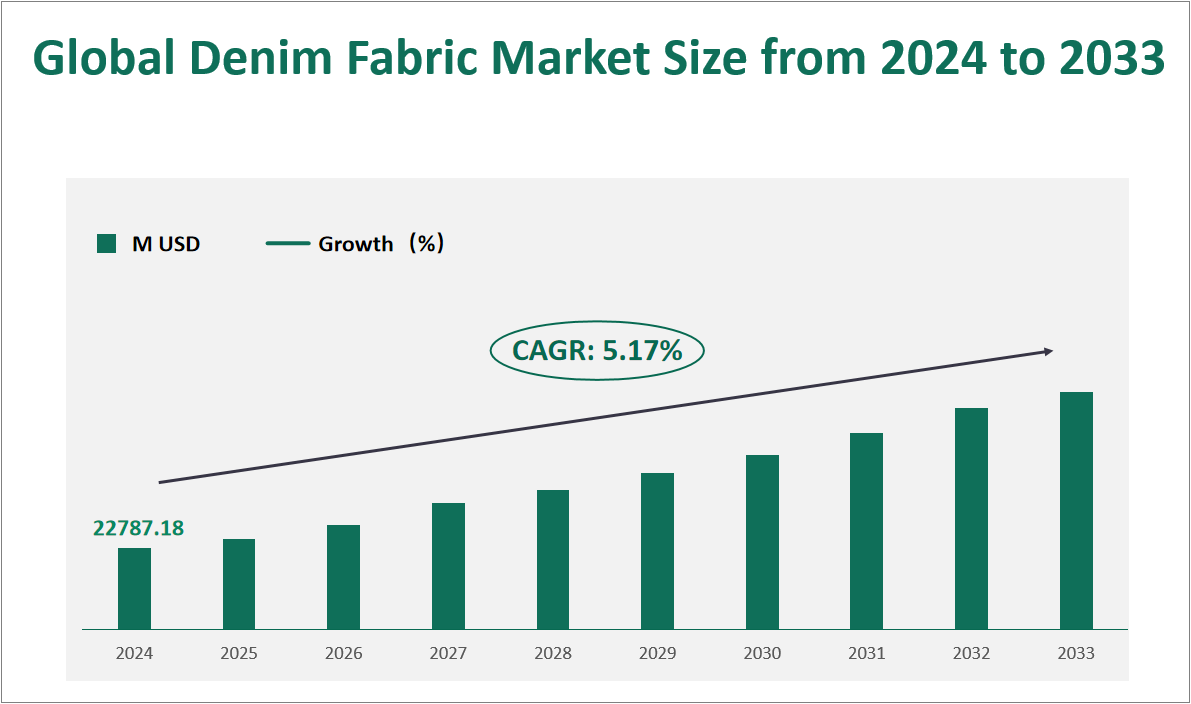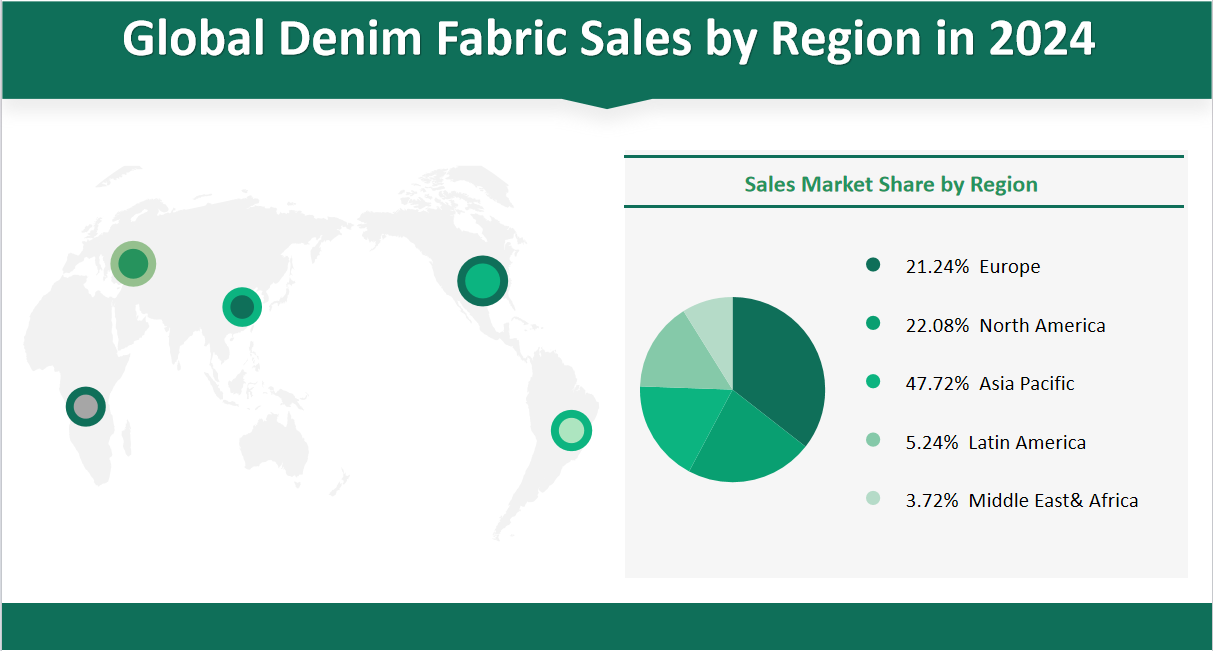1 Global Denim Fabric Market Outlook
The global Denim Fabric market is projected to exhibit substantial growth in the coming years, with a CAGR of 5.17% from 2024 to 2033, reaching a total market size of $22787.18 million USD in 2024. Denim fabric is a durable cotton twill fabric widely used in the apparel industry, particularly for jeans, jackets, and other casual wear. It is characterized by its diagonal ribbing and high tensile strength, making it ideal for garments that require durability and longevity. Denim fabric is produced using a twill weave, which enhances its strength and ability to withstand friction. The fabric’s versatility and comfort have made it a staple in fashion, transcending age and gender barriers. Denim is not only used in clothing but also in accessories and home furnishings, further expanding its market reach.
Figure Global Denim Fabric Market Size and Growth Rate (2024-2033)

2 Denim Fabric Market Growth Drivers and Constraints
The growth of the global denim fabric market is influenced by several key factors. On the positive side, the increasing popularity of denim apparel is a primary driver. Denim jeans and jackets are versatile and can be worn on various occasions, from casual to formal settings. The rising number of women joining the workforce and the growing trend of casual wear in the workplace have further fueled the demand for denim fabric. Additionally, the influence of westernization and urbanization in emerging economies has led to increased fashion consciousness among consumers, driving the market’s expansion.
However, the market faces several challenges. One significant limiting factor is the environmental impact of traditional denim production, which involves the use of synthetic chemicals and elastane. The disposal of these materials poses environmental concerns, leading to a push for more sustainable alternatives. Additionally, the availability of substitutes such as chiffon, crepe, and synthetic fabrics presents a competitive threat to denim fabric. The high price of cotton, a primary raw material, also affects the market, as fluctuations in cotton prices can impact production costs and profitability.
3 Denim Fabric Market Innovations and M&A Activities
Technological innovation is a crucial aspect of the denim fabric market. Companies are continuously investing in research and development to improve the quality and sustainability of their products. For example, advancements in fabric technology have led to the development of bi-stretch denim, which offers better flexibility and comfort compared to traditional stretch denim. Additionally, hybrid fabric blends and the use of advanced polyesters are becoming more prevalent, providing consumers with a wider range of options.
Corporate mergers and acquisitions are also shaping the industry. For instance, Vicunha Textil collaborated with Adriano Goldschmied to develop a sustainable denim collection called “Absolut Eco,” which uses pre-consumer recycled fabric to reduce water consumption and chemical use. Jindal Worldwide’s acquisition of Earth Energy highlights the trend of companies expanding into new markets and technologies. These strategic moves not only enhance market positions but also drive innovation and sustainability within the industry.
In conclusion, the global denim fabric market is poised for steady growth, driven by increasing demand and technological advancements. However, it must navigate environmental and competitive challenges to sustain its expansion. Through continuous innovation and strategic corporate activities, the industry is well-positioned to meet future demands while addressing sustainability concerns.
4 Global Denim Fabric Market Analysis by Type
In 2024, the global denim fabric market is projected to have sales of 8,007.7 million meters. The market share distribution by type is as follows: Light Denim Fabric is expected to account for 50.00% of the total sales, with 4,004.1 million meters; Medium Denim Fabric is projected to hold 37.75% of the market, amounting to 3,022.5 million meters; and Heavy Denim Fabric is anticipated to make up 12.25%, with 981.1 million meters. This indicates that Light Denim Fabric continues to dominate the market, followed by Medium Denim Fabric, while Heavy Denim Fabric maintains a smaller but significant share.
Table Global Denim Fabric Sales and Share by Type in 2024
Type | Sales in 2024 (M Meters) | Market Share in 2024 (%) |
|---|---|---|
Light Denim Fabric | 4004.1 | 50.00% |
Medium Denim Fabric | 3022.5 | 37.75% |
Heavy Denim Fabric | 981.1 | 12.25% |
5 Global Denim Fabric Market Analysis by Application
In 2024, the global denim fabric market is projected to achieve sales of 8,007.7 million meters. The market share distribution by application is as follows: Jeans are expected to dominate the market with 60.29%, translating to approximately 4,827.9 million meters; Shirts are projected to account for 9.83%, equating to 786.9 million meters; Jackets are anticipated to hold 12.68% of the market with 1,015.4 million meters; and other applications are expected to represent 17.20%, amounting to 1,377.5 million meters. This data highlights the continued prominence of jeans in the denim fabric market, while shirts, jackets, and other applications also contribute to the overall sales.
Table Global Denim Fabric Sales and Share by Application in 2024
Application | Sales in 2024 (M Meters) | Market Share in 2024 (%) |
|---|---|---|
Jeans | 4827.9 | 60.29% |
Shirt | 786.9 | 9.83% |
Jacket | 1015.4 | 12.68% |
Others | 1377.5 | 17.20% |
6 Global Denim Fabric Market Analysis by Region
In 2024, the global denim fabric market is projected to have sales of 8,007.7 million meters. The regional distribution of sales and market share is as follows: North America is expected to account for 22.08% of the total sales, with 1,768.2 million meters; Europe is projected to hold 21.24%, amounting to 1,700.4 million meters; Asia-Pacific is anticipated to dominate with 47.72%, reaching 3,821.6 million meters; Latin America is expected to contribute 5.24%, with 419.4 million meters; and the Middle East & Africa are projected to hold 3.72%, totaling 298.0 million meters. This forecast highlights the significant role of Asia-Pacific in the global denim fabric market, while North America and Europe also maintain substantial shares.
Figure Global Denim Fabric Market Share by Region in 2024

7 Top 3 Companies of Global Denim Fabric Market
7.1 Isko
Company Introduction and Business Overview:
Isko is a leading global denim producer headquartered in Turkey. Established in 1983, Isko has grown to become a prominent player in the denim fabric market, recognized for its commitment to quality, innovation, and sustainability. The company operates state-of-the-art manufacturing facilities that utilize advanced technology to produce a wide range of denim products. Isko is known for its eco-friendly practices, being the first denim manufacturer to receive both the Nordic Swan and EU Ecolabel certifications, which highlight its dedication to sustainability in the textile industry.
Products Offered:
Isko offers an extensive portfolio of denim fabrics, including light, medium, and heavy denim options. Their product lines cater to various market segments, including fashion, casual wear, and workwear. Notable innovations from Isko include the ISKO Blue Skin™, a high-performance stretch denim that provides comfort and flexibility while minimizing environmental impact. The company also focuses on developing sustainable denim solutions, incorporating recycled materials and reducing water consumption in the production process.
Sales Revenue in the Latest Year:
Isko reported sales revenue of approximately USD 544.42 million, reflecting its strong market presence and the growing demand for its innovative denim products.
7.2 Vicunha
Company Introduction and Business Overview:
Vicunha Textil S/A, founded in 1946 and headquartered in Brazil, is one of the largest textile producers in Latin America. The company specializes in the production of denim and other textile fibers, with a strong emphasis on quality and sustainability. Vicunha has established itself as a global reference in jeanswear solutions, operating in various international markets, including Europe and Asia. With over 75 years of experience, Vicunha is recognized for its innovative approach to denim production and its ability to adapt to changing fashion trends.
Products Offered:
Vicunha’s product range includes a variety of denim fabrics, such as light, medium, and heavy denim, designed for different applications, including jeans, jackets, and shirts. The company is particularly known for its Adele Power Denim, a premium fabric that combines high stretch with a sophisticated look, catering to both male and female markets. Vicunha is also committed to sustainability, having developed the Absolut Eco collection in collaboration with renowned designer Adriano Goldschmied, which utilizes pre-consumer recycled denim to minimize environmental impact.
Sales Revenue in the Latest Year:
Vicunha reported sales revenue of approximately USD 379.89 million, demonstrating its robust position in the denim fabric market and its ability to meet the demands of a diverse customer base.
7.3 Jindal Worldwide
Company Introduction and Business Overview:
Jindal Worldwide Ltd., established in 1986 and headquartered in India, is a prominent player in the textile industry, specializing in denim and home textiles. The company has a strong focus on innovation and quality, which has allowed it to expand its market presence both domestically and internationally. Jindal Worldwide is known for its vertically integrated operations, which enable it to maintain control over the entire production process, from yarn manufacturing to finished denim products.
Products Offered:
Jindal Worldwide offers a wide range of denim fabrics, including various weights and finishes. The company’s denim products cater to different segments, including casual wear, workwear, and high-fashion applications. Jindal’s commitment to quality is evident in its use of advanced manufacturing techniques and state-of-the-art machinery. The company also focuses on sustainability, integrating eco-friendly practices into its production processes.
Sales Revenue in the Latest Year:
Jindal Worldwide reported sales revenue of approximately USD 284.95 million, reflecting its strong market position and the growing demand for its diverse range of denim products.

